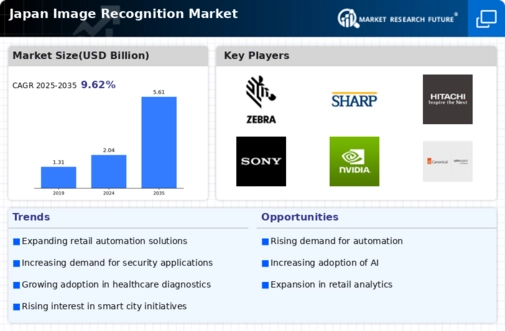Growing E-commerce Sector
The rapid expansion of the e-commerce sector in Japan is a key driver for the image recognition market. As online shopping continues to gain popularity, retailers are increasingly leveraging image recognition technologies to enhance customer experiences. Features such as visual search and personalized recommendations based on image analysis are becoming commonplace. Recent data indicates that Japan's e-commerce market is projected to reach approximately $200 billion by 2025, with a significant portion of this growth attributed to advancements in image recognition capabilities. This trend suggests that businesses are recognizing the value of integrating image recognition into their platforms to improve user engagement and drive sales, thereby contributing to the overall growth of the image recognition market.
Rising Demand for Automation
The image recognition market in Japan is experiencing a notable surge in demand for automation across various sectors. Industries such as manufacturing and logistics are increasingly adopting image recognition technologies to streamline operations and enhance efficiency. For instance, automated quality control systems utilize image recognition to identify defects in products, thereby reducing waste and improving overall productivity. According to recent estimates, the automation sector in Japan is projected to grow at a CAGR of approximately 8% over the next five years, which is likely to drive further investments in image recognition solutions. This trend indicates a shift towards more intelligent systems that can analyze visual data in real-time, ultimately transforming traditional workflows and contributing to the growth of the image recognition market.
Integration with AI Technologies
The integration of artificial intelligence (AI) with image recognition technologies is significantly influencing the image recognition market in Japan. AI algorithms enhance the accuracy and efficiency of image recognition systems, enabling applications in various fields such as retail, security, and healthcare. For example, AI-powered facial recognition systems are being deployed in public spaces for security purposes, while retail businesses utilize AI to analyze customer behavior through image data. The Japanese government has recognized the potential of AI, investing over $1 billion in AI research and development initiatives. This investment is expected to bolster the capabilities of image recognition technologies, thereby expanding their applications and driving growth in the image recognition market.
Advancements in Mobile Technology
The proliferation of mobile technology in Japan is significantly impacting the image recognition market. With the widespread use of smartphones equipped with advanced cameras, consumers are increasingly utilizing image recognition applications for various purposes, including shopping, social media, and augmented reality experiences. The mobile app market in Japan is projected to grow at a CAGR of around 10% over the next few years, which is likely to drive demand for innovative image recognition solutions. Companies are investing in mobile applications that incorporate image recognition features, enhancing user engagement and providing new avenues for marketing. This trend suggests that the image recognition market is poised for growth as mobile technology continues to evolve and integrate with everyday consumer activities.
Increased Investment in Smart Cities
Japan's commitment to developing smart cities is fostering growth in the image recognition market. As urban areas become more technologically advanced, the demand for image recognition solutions in public safety, traffic management, and urban planning is on the rise. For instance, image recognition systems are being utilized for monitoring traffic patterns and enhancing public safety through surveillance. The Japanese government has allocated substantial funding for smart city initiatives, with investments expected to exceed $10 billion by 2027. This focus on smart city development indicates a growing reliance on image recognition technologies to create safer and more efficient urban environments, thus propelling the image recognition market forward.
























Leave a Comment